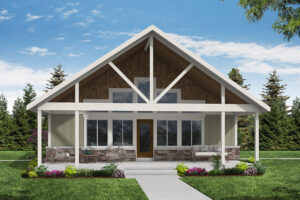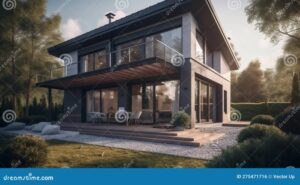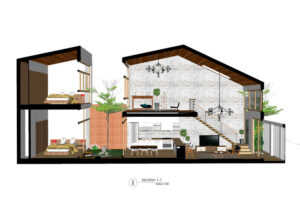
3D-printed furniture designs are revolutionizing the way we view and utilize our living spaces. This innovative technology allows for the creation of unique, customized pieces that not only meet individual needs but also push the boundaries of traditional design. With advancements in materials and techniques, 3D printing is making waves in the furniture industry, offering solutions that combine functionality with aesthetic appeal.
As we delve deeper into this topic, we’ll explore the benefits and challenges of 3D printing in furniture design, showcase some awe-inspiring examples, and discuss how this technology aligns with sustainable practices. Whether you’re an enthusiast or simply curious about the future of furniture, this journey into the world of 3D-printed designs promises to be insightful and engaging.
Introduction to 3D-Printed Furniture Designs
The world of furniture design is experiencing a transformative shift with the advent of 3D printing technology. This innovative approach allows designers and manufacturers to create customized furniture pieces with greater efficiency and creativity than traditional methods. By utilizing digital fabrication techniques, 3D-printed furniture can be tailored to meet specific needs and preferences, leading to a new era of personalization in the home and office.The fundamental technology behind 3D printing involves the additive manufacturing process, where material is deposited layer by layer to form a three-dimensional object.
This method not only streamlines production but also reduces waste significantly, as only the necessary amount of material is used. Additionally, 3D printing opens up opportunities for complex geometries and designs that were previously difficult or impossible to achieve with conventional manufacturing techniques. However, there are challenges associated with this technology, including limitations in material choices and the need for specialized knowledge in CAD (computer-aided design).
Benefits of 3D Printing in Furniture Design
D printing offers numerous advantages that have the potential to revolutionize the furniture industry. Understanding these benefits is essential for both designers and consumers. Key advantages include:
- Customization: 3D printing allows for personalized designs that cater to individual tastes, sizes, and functional requirements.
- Reduced Waste: The additive nature of 3D printing minimizes material waste, making it an environmentally friendly choice compared to traditional manufacturing methods.
- Complex Designs: Designers can create intricate and detailed patterns that enhance aesthetic appeal and functionality.
- Cost Efficiency: While initial setup costs can be high, the reduction in material waste and the ability to produce on-demand can lead to significant long-term savings.
- Rapid Prototyping: Designers can quickly iterate on their designs, allowing for faster development cycles and innovation.
Challenges in 3D Printing for Furniture
Despite its advantages, 3D printing in furniture design comes with several challenges that need to be addressed. Recognizing these obstacles is crucial for successful implementation. Some notable challenges include:
- Material Limitations: Current 3D printing materials may not always match the durability and finish of traditional furniture materials like wood and metal.
- Production Speed: While small batches can be printed quickly, large-scale production still requires time compared to conventional methods.
- Technical Expertise: Designers must have a solid understanding of CAD software and 3D printing processes to create effective designs.
- Market Acceptance: Some consumers may be hesitant to embrace 3D-printed furniture due to perceptions about quality or aesthetic appeal.
Recent Advancements in 3D Printing Technology
The furniture industry has witnessed significant advancements in 3D printing technology that enhance both design capabilities and material options. Staying informed on these developments can lead to better design choices and improved product offerings. Noteworthy advancements include:
- New Materials: Advances in composite materials and bioplastics have led to stronger and more flexible options for 3D printing furniture.
- Improved Printing Speed: Innovations in printer technology have significantly reduced the time required to produce finished products.
- Multi-Material Printing: The ability to print with multiple materials in a single print run allows for more complex and versatile designs.
- Integration with Smart Technology: Some 3D-printed furniture is now being designed to integrate seamlessly with smart home technologies, enhancing functionality.
- Collaboration with Designers: Partnerships between furniture brands and tech companies are leading to innovative design solutions that merge aesthetics with functionality.
Innovative 3D-Printed Furniture Designs
The realm of 3D-printed furniture design has seen remarkable innovations, enabling designers to create unique and functional pieces that challenge traditional furniture-making methods. These designs not only enhance aesthetic appeal but also prioritize sustainability and efficiency in production. As technology progresses, the possibilities for customization and functionality continue to expand, transforming how we perceive and interact with furniture in our living spaces.One standout example of innovative 3D-printed furniture is the “Giant” chair, designed by the Italian design firm Studio Brichet-Ziegler.
This piece exemplifies the capabilities of 3D printing, with its intricate, organic forms that mimic natural structures. The chair is made from a biodegradable composite material that significantly reduces its environmental footprint. Another remarkable design is the “3D-Printed Coral” table by artist and designer Ben van Berkel, which is inspired by marine ecosystems. The table showcases an intricate pattern that not only serves an aesthetic purpose but also optimizes structural integrity, demonstrating the dual functionality of 3D printing in furniture.
Material Options for 3D Printing Furniture
The choice of materials in 3D printing is crucial to both the aesthetic qualities and durability of the furniture. Various options provide designers with the flexibility to create pieces that meet specific functional requirements while also aligning with sustainable practices. Here are some popular materials used in 3D-printed furniture:
- PLA (Polylactic Acid): A biodegradable thermoplastic derived from renewable resources like corn starch or sugarcane. PLA is easy to print, making it a popular choice for prototypes and decorative elements.
- ABS (Acrylonitrile Butadiene Styrene): Known for its strength and impact resistance, ABS is widely used in functional furniture pieces. Its durability makes it suitable for items that will see frequent use.
- PETG (Polyethylene Terephthalate Glycol): This material combines the ease of printing of PLA with the strength of ABS. PETG is known for being food-safe, making it ideal for kitchen-related furniture.
- Wood Filament: Composed of a plastic base infused with wood fibers, this material allows the creation of furniture that retains a natural wood-like appearance, appealing to eco-conscious consumers.
- Metal Filament: Comprising a composite of metal powder and plastic, metal filaments provide a unique aesthetic and are often used for decorative elements that require a premium finish.
The selection of the right material is vital for achieving desired functionality and aesthetic appeal. Each material offers distinct advantages that can be harnessed to create innovative designs that meet modern consumer needs while embracing eco-friendly practices. As 3D printing technology continues to advance, the development of new materials will further expand the horizons of what is possible in furniture design.
Eco-Friendly Aspects of 3D-Printed Furniture
The rise of 3D-printed furniture is not just a trend in design; it represents a significant shift towards sustainability in the furniture industry. As environmental concerns continue to mount, the use of eco-friendly materials and processes in 3D printing offers a promising solution for reducing our ecological footprint while furnishing our spaces.D printing is revolutionizing the way furniture is created, primarily by using sustainable materials that minimize environmental impact.
Traditional furniture manufacturing often relies on wood and synthetic materials that contribute to deforestation and pollution. In contrast, 3D printing utilizes a variety of eco-friendly materials such as biodegradable plastics, recycled polymers, and even organic materials like mycelium and biocomposites. These materials not only support sustainable practices but also provide innovative solutions tailored to modern design needs.
Sustainable Materials Used in 3D Printing
The materials employed in 3D printing for furniture play a crucial role in its sustainability. Some of the most notable materials include:
- PLA (Polylactic Acid): This biodegradable plastic, made from renewable resources such as cornstarch, is a popular choice for 3D printing furniture. It breaks down more readily than traditional plastics, making it a safer choice for the environment.
- Recycled PET (rPET): Derived from recycled plastics, rPET reduces the need for new plastic production, effectively lowering carbon emissions and conserving resources.
- Mycelium: Utilizing the root structure of mushrooms, mycelium can be grown into various shapes, creating strong, lightweight furniture while being fully biodegradable.
- Wood Filaments: These are composites made from wood particles mixed with polymers, offering the aesthetic and tactile qualities of wood along with the benefits of 3D printing.
Reduction of Waste Compared to Traditional Manufacturing
One of the most significant advantages of 3D printing is its ability to reduce waste in the production process. Traditional manufacturing often involves cutting and shaping materials, resulting in substantial waste. In contrast, 3D printing is an additive process where objects are built layer by layer, which significantly minimizes material waste.
“3D printing can reduce material waste by up to 90% compared to conventional methods.”
This efficiency not only conserves resources but also lowers production costs. For instance, furniture pieces can be designed for optimal material usage, ensuring that every part of the design is functional and necessary. This approach not only supports sustainable practices but also encourages designers to think critically about their creations.
3D-Printed Furniture and Green Living
The integration of 3D-printed furniture into our living spaces promotes a more eco-conscious lifestyle. By choosing furniture that is sustainably sourced and manufactured, consumers can reduce their environmental impact. Furthermore, the customization capabilities of 3D printing allow for more compact and efficient designs, making it easier to adapt furniture to smaller spaces, thereby reducing the overall demand for new materials.D-printed furniture also encourages the use of local materials and production methods, which can lower transportation emissions and support local economies.
For example, a 3D printing studio could use locally sourced bioplastics or recycled materials to produce furniture items tailored specifically for their community. This local approach not only fosters a sense of community but also aligns with the principles of green living by reducing carbon footprints associated with shipping and logistics.In conclusion, as the furniture industry continues to evolve, embracing 3D printing technology offers a path towards a more sustainable future.
Through the use of eco-friendly materials, waste reduction, and a commitment to promoting environmentally responsible practices, 3D-printed furniture stands at the forefront of the green revolution in design.
Integration of 3D-Printed Furniture in Home Décor
Integrating 3D-printed furniture into home décor offers a unique opportunity to enhance various interior styles while ensuring both functionality and aesthetic appeal. With endless design possibilities, 3D-printed pieces can seamlessly blend into any space, from modern minimalist to cozy rustic settings. This section explores how to effectively incorporate 3D-printed furniture into different home styles, emphasizing color, design choices, and organizational tips for harmonizing these innovative pieces with traditional furnishings.
Room Setups Featuring 3D-Printed Furniture
Creating room setups that incorporate 3D-printed furniture requires an understanding of both the pieces and the overall décor style. Here are several examples of how these innovative items can be integrated into different home styles:
- Modern Minimalist: A sleek 3D-printed coffee table can serve as a focal point in a living room characterized by neutral tones and clean lines. Pair it with a low-profile sofa in muted shades and a geometric rug to enhance the minimalist vibe.
- Industrial: In an industrial-style loft, 3D-printed chairs with a raw, unfinished look can complement exposed brick walls and metal accents. Adding a 3D-printed bookshelf can bring in an artistic flair while maintaining functionality.
- Bohemian: For a bohemian-inspired space, colorful 3D-printed planters can be placed around the room to showcase lush greenery. Mixing these with vintage furniture pieces creates a vibrant, eclectic atmosphere.
- Scandinavian: Light-colored 3D-printed lamps paired with Scandinavian furniture create a harmonious look. Incorporating natural elements, such as wooden accents and textiles, can balance the modernity of the 3D-printed pieces.
Color and Design Choices for 3D-Printed Pieces
Selecting the right colors and designs for 3D-printed furniture is crucial in ensuring that they complement existing décor. Here are some effective strategies to consider:
- Color Matching: Choose colors that either match or contrast well with the dominant hues in the room. For neutral spaces, vibrant 3D-printed pieces can act as statement furniture, while in colorful environments, opting for softer tones can prevent visual chaos.
- Texture Consideration: The texture of 3D-printed furniture can significantly impact the overall design. Pair smooth surfaces with rough textures and vice versa to create visual interest. For instance, a smooth, glossy 3D-printed table can be beautifully offset by a rustic wooden bench.
- Design Harmony: Ensure that the design of the 3D-printed piece aligns with the overall theme of the home. Curvy, organic shapes work well in casual settings, while geometric and angular designs are ideal for modern aesthetics.
Organizational Tips for Combining 3D-Printed Furniture with Traditional Items
Successfully mixing 3D-printed furniture with traditional items can enhance the overall functionality and visual appeal of any space. Consider the following tips to achieve a cohesive look:
- Balance Proportions: When integrating 3D-printed pieces with traditional furniture, maintain balance in proportions. Ensure that larger 3D-printed items do not overwhelm smaller traditional pieces, and vice versa. This creates a harmonious distribution of visual weight.
- Layering Textures: Combine various textures by pairing 3D-printed furniture with textiles like woven throws or patterned cushions. This layering technique adds depth and interest while ensuring that the 3D-printed items don’t look out of place.
- Consistent Styling: Use color palettes and design motifs that echo throughout both the 3D-printed and traditional pieces. This could be as simple as using similar colors or matching patterns to tie everything together.
3D-Printed Furniture for Specific Home Needs
D-printed furniture offers innovative solutions tailored to meet diverse home requirements. By leveraging the unique capabilities of 3D printing technology, designers can create custom pieces that fit specific aesthetics and functional needs, making homes more comfortable and accessible for everyone. This section delves into how 3D printing can cater to particular requirements, such as optimizing space in small apartments, enhancing accessibility for individuals with disabilities, and showcasing real-life success stories from families who have benefited from these advancements.
Customization for Small Spaces
In urban living, maximizing space is crucial, and 3D-printed furniture excels in creating multifunctional pieces that fit snugly into tight corners. Designers can craft items that serve multiple purposes while maintaining a sleek design, making them perfect for small apartments or homes. Some popular examples include:
- Foldable Tables: Tables that can collapse into a compact form when not in use. This design maximizes utility while minimizing clutter.
- Modular Shelving Units: Customizable shelving that can be arranged in various configurations to suit different needs, allowing maximum use of vertical space.
- Compact Seating Solutions: Lightweight chairs and benches that provide comfort without occupying much floor area, ideal for studio apartments.
Accessibility Features in 3D-Printed Furniture
D printing enables the incorporation of specific accessibility features in furniture design, facilitating a more inclusive environment for individuals with disabilities. Customizable aspects can be tailored to the unique needs of users, ensuring that everyone can navigate their spaces comfortably. Key accessibility features can include:
- Adjustable Heights: Furniture pieces that can be easily adjusted for individuals using wheelchairs or those who prefer standing.
- Ergonomic Designs: Chairs and tables with designs that support proper posture and ease of use, enhancing comfort for long-term sitting or working.
- Easy-to-Grasp Handles: Custom-created furniture with larger or uniquely shaped handles that make it easier for individuals with limited dexterity to open and close drawers and cabinets.
Case Studies of Unique Needs
Several families have transformed their living environments with the help of 3D-printed furniture designed to meet their specific needs. For example, the Smith family, who have a child with mobility challenges, benefited significantly from a custom-designed dining table with an adjustable height feature. This table not only accommodates the child’s wheelchair but also promotes family interactions during mealtime.Another case is the Garcia family, living in a compact urban apartment.
They utilized 3D printing to create a multi-purpose sofa that folds out into a bed, providing both seating and sleeping arrangements without taking up excessive space. This innovative design has allowed them to host guests comfortably while maintaining their living area’s functionality.These examples illustrate the transformative impact of 3D-printed furniture, showcasing how it can be tailored to individual needs while enhancing overall home functionality and aesthetics.
Impact on Heating and Air Conditioning Designs
The integration of 3D-printed furniture into home environments is revolutionizing how we approach the design of heating, ventilation, and air conditioning (HVAC) systems. The versatility of 3D printing allows for custom furniture that not only enhances aesthetic appeal but also contributes to energy efficiency and climate control. As furniture becomes more integrated with HVAC designs, it opens up new possibilities for improving indoor air quality and thermal comfort.Custom 3D-printed furniture can be designed with specific geometries that optimize airflow and temperature regulation.
For instance, pieces like chairs or tables can incorporate built-in channels for air circulation, allowing conditioned air to flow freely throughout the room. This design innovation ensures that HVAC systems can operate more effectively, potentially lowering energy consumption and enhancing comfort levels.
Integration Methods for Energy Efficiency
Effective integration of furniture design with energy-efficient solutions can significantly impact home comfort and utility costs. Here are several methods through which 3D-printed furniture can harmonize with HVAC systems:
- Airflow-enhancing Designs: Creating furniture with integrated air ducts or vents can promote better airflow, reducing the dependency on HVAC systems for temperature control.
- Material Selection: Utilizing materials with thermal mass properties in furniture can help regulate indoor temperatures by absorbing heat during the day and releasing it at night.
- Modular Configurations: 3D-printed furniture can feature modular designs that allow for easy reconfiguration, ensuring optimal airflow and comfort as home layouts change.
- Sensory Integration: Incorporating sensors within furniture that monitor temperature and humidity can facilitate real-time adjustments in HVAC settings, allowing for more efficient energy use.
Collaboration between furniture designers and HVAC experts is essential to maximize these benefits. By working together, they can create solutions that not only fulfill aesthetic desires but also focus on improving energy efficiency.
“By merging the worlds of furniture design and HVAC engineering, we can create spaces that are not only beautiful but also intelligently designed for comfort and sustainability.”
This partnership can lead to innovative solutions such as 3D-printed furniture that adapts to changing environmental conditions, thereby enhancing comfort while reducing energy consumption. For example, a designer might work with HVAC specialists to create a 3D-printed coffee table that includes hidden ventilation systems that respond to the room’s temperature, further optimizing HVAC efficiency. In summary, the potential impact of 3D-printed furniture on HVAC design is vast, promising a future where home environments are both stylish and energy-efficient.
Home Inspections and 3D-Printed Furniture
As 3D-printed furniture becomes more common in modern homes, its presence significantly influences home inspection processes. Inspectors must adapt to the unique characteristics and potential challenges presented by this innovative furniture. Understanding the implications of 3D-printed materials and methods is crucial for ensuring safety and durability within residential spaces.One of the key impacts of 3D-printed furniture on home inspections is its durability and material composition.
Unlike traditional furniture, which is often made from solid wood or metal, 3D-printed items can utilize a variety of materials, such as PLA, ABS, or composite resins. Each material has different properties that may affect its long-term performance and stability. Inspectors should be aware of the following concerns when evaluating 3D-printed furniture:
Durability and Safety Considerations
Inspectors need to assess various aspects of 3D-printed furniture that could pose risks. The following points highlight important concerns to consider during inspections:
- Material Integrity: Inspectors should check for any signs of warping, cracking, or degradation that can affect the furniture’s strength over time. For example, PLA may become brittle when exposed to high heat, which could compromise its structure.
- Weight-Bearing Capacity: Unlike traditional materials, some 3D-printed designs may have weight limitations due to their construction. Inspectors should verify that the furniture meets safety standards for its intended use, particularly for items like chairs or tables.
- Fire Resistance: The fire resistance of 3D-printed materials can vary. It’s crucial for inspectors to check if the materials used meet local fire codes, especially in densely furnished areas.
- Stability: Unique geometries in 3D-printed designs can impact stability. Inspectors should evaluate whether the furniture is securely constructed and balanced to prevent tipping or accidents.
Best practices for homeowners can significantly enhance the longevity and safety of 3D-printed furniture during home inspections. Maintaining this furniture requires understanding its care and upkeep needs. Here are some effective strategies to ensure durability:
Maintenance Practices for 3D-Printed Furniture
Proper maintenance of 3D-printed furniture is essential for sustaining its functionality and appearance. Homeowners should implement the following practices:
- Regular Cleaning: Use mild cleaners and soft cloths to avoid damaging the surface. Avoid harsh chemicals that may degrade the material over time.
- Temperature Control: Keep 3D-printed items away from direct sunlight and heat sources to prevent warping or discoloration.
- Periodic Inspections: Homeowners should regularly check for any signs of wear or damage, such as cracks or loose connections, to address issues before they worsen.
- Weight Management: Be mindful of the weight limits of 3D-printed items. Avoid placing excessively heavy objects on these pieces to preserve their structural integrity.
By understanding the unique attributes of 3D-printed furniture, inspectors can conduct thorough assessments while homeowners can ensure their pieces remain both functional and aesthetically pleasing.
Future Trends in 3D-Printed Furniture

The landscape of furniture design is on the brink of transformation, largely driven by 3D printing technology. As advancements continue to emerge, we can anticipate innovative designs that will redefine aesthetics, functionality, and sustainability. This transformative approach not only enhances customization but also influences the entire process of furniture production, paving the way for a new era in home décor.Future innovations in 3D printing technology are expected to focus on several key areas, improving both the quality and efficiency of furniture design.
These advancements will likely include enhanced printing materials, sophisticated software for design, and increased accessibility for consumers and designers alike. As these technologies evolve, they will empower more creators to experiment and push the boundaries of conventional furniture styles.
Innovative Materials and Techniques
The future of 3D-printed furniture will be heavily influenced by the development of new materials and techniques. Designers are exploring a range of sustainable and versatile materials that can be utilized in the 3D printing process, such as biodegradable plastics and recycled composites. These innovations not only allow for unique textures and finishes but also promote eco-conscious manufacturing practices. The integration of smart materials that can change properties based on environmental conditions is also on the horizon.
Global Design Trends Impacted by 3D Printing
As 3D-printed furniture gains traction, its influence on global design trends becomes increasingly prominent. The ability to create customized pieces on-demand will lead to a more personalized approach to home décor. This trend also promotes a shift toward minimalism and multifunctionality in furniture design, catering to the demands of urban living. Concepts such as modular furniture that can be easily reconfigured or expanded will become more commonplace, allowing consumers to adapt their spaces easily.
Emerging Designers and Brands
Several designers and brands are becoming pioneers in the realm of 3D-printed furniture, pushing the boundaries of creativity and functionality. One such name is Zaha Hadid Design, known for its iconic and fluid forms that challenge traditional design paradigms. Additionally, brands like VITRA and IKEA are exploring collaborations with 3D printing startups to integrate innovative furniture solutions into their offerings.
These emerging talents are not only redefining aesthetic sensibilities but are also advocating for sustainable practices within the industry.
“The future of furniture design lies in the intersection of technology and creativity, where 3D printing allows for unprecedented customization and sustainability.”
Exploring House Plans with 3D-Printed Furniture
As the world of interior design evolves, so does the integration of innovative technologies like 3D printing. This approach offers architects and homeowners unique opportunities to incorporate custom furniture solutions into house plans, enhancing both aesthetics and functionality. By designing spaces that explicitly accommodate 3D-printed furniture, one can create a harmonious living environment that meets personal needs and reflects modern design sensibilities.Incorporating 3D-printed furniture into house plans involves thoughtful consideration of layout and functionality.
By using furniture that can be precisely tailored to specific dimensions and needs, architects can optimize living spaces. These pieces can be designed to enhance the flow of the home, ensuring that every area serves a purpose while maintaining an inviting atmosphere. For example, a small apartment can benefit from modular 3D-printed furniture that can be easily reconfigured as needed, maximizing space without sacrificing comfort.
Sample House Plans with 3D-Printed Furniture Solutions
Creating effective house plans that incorporate 3D-printed furniture requires a clear understanding of both the structural elements and the unique characteristics of these custom pieces. Here are some examples that highlight the potential of this innovative approach:
- Open Concept Living Space: An expansive living area features a custom 3D-printed sectional sofa that perfectly fits the space, encouraging social interaction and relaxation. A bespoke coffee table with integrated storage solutions can enhance functionality while maintaining a sleek aesthetic.
- Compact Studios: In a studio apartment design, 3D-printed multifaceted furniture can play a crucial role. A combined bed and workspace, designed to fold away when not in use, optimizes limited square footage while providing comfort and utility.
- Family Homes: A family-oriented house plan might include 3D-printed dining furniture that accommodates varying numbers of guests. A table that can expand or contract based on need offers versatility and ease of use, making family gatherings a breeze.
- Outdoor Integration: For homes with outdoor spaces, 3D-printed patio furniture can be designed to withstand the elements while providing comfort. This furniture can be tailored to fit specific outdoor layouts, creating seamless transitions between indoor and outdoor living areas.
Enhancing Functionality with Specific House Designs
Different house designs can significantly enhance the functionality of 3D-printed pieces. By understanding how space and furniture interact, architects can ensure that each piece serves its intended purpose effectively. For instance, in a modern minimalist home, the clean lines and simple forms of 3D-printed furniture can complement the overall aesthetic. Features such as built-in storage or modular elements that adapt to changing needs can maximize the utility of space without cluttering it.
“A well-designed home incorporates furniture that is not just functional, but also a reflection of the homeowner’s personality and lifestyle.”
Collaboration Tips for Architects and Furniture Designers
Creating a cohesive look between the structural design of a house and its furnishings requires collaboration between architects and furniture designers. Here are some tips to facilitate this partnership:
- Establish Clear Communication: Regular meetings and open dialogue ensure that both parties understand the project goals and limitations. Sharing initial sketches and ideas can lead to more integrated designs.
- Focus on Customization: Both architects and designers should prioritize the customization potential of 3D-printed furniture to ensure it fits seamlessly within the house plan.
- Consider Material Compatibility: Understanding the materials used in both the structure and the furniture can prevent issues down the line. This includes considering weight, durability, and aesthetics.
- Prototype Testing: Creating prototypes of furniture pieces can help visualize their impact on space before finalizing designs. This hands-on approach enables adjustments to be made for optimal functionality and style.
By thoughtfully integrating 3D-printed furniture into house plans, architects can elevate both the design and functionality of residential spaces. The collaboration between architects and furniture designers is key to achieving a cohesive and innovative living environment that meets the demands of modern life.
Final Summary

In conclusion, the world of 3D-printed furniture designs is not just about creating stylish pieces but also about embracing a sustainable and innovative approach to living. As technology continues to evolve, we can expect even more exciting developments that will redefine our homes and lifestyles. Whether integrating these pieces into your décor or considering their impact on future designs, 3D printing is undoubtedly shaping the future of how we perceive and interact with furniture.
Answers to Common Questions
What are the advantages of 3D-printed furniture?
3D-printed furniture offers customization, reduced waste, and can be produced quickly, making it an efficient alternative to traditional manufacturing.
Are 3D-printed furniture pieces durable?
Yes, many 3D-printed materials are designed for durability, though maintenance and quality can vary based on the material and design.
How does 3D printing contribute to sustainability?
3D printing minimizes material waste during production and allows for the use of eco-friendly materials, making it a more sustainable choice.
Can 3D-printed furniture be mass-produced?
Yes, while 3D printing is often associated with custom designs, it can also be scaled for mass production, particularly for popular styles and designs.
How can I incorporate 3D-printed furniture into my home?
You can mix and match 3D-printed pieces with traditional furniture, focusing on complementary colors and styles for a cohesive look.





